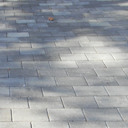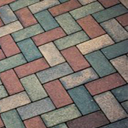Concrete Pavers

The first concrete pavers were shaped just like a brick and they were called Holland Stones and still are today. These units turn out to be far more economical to produce and were exceedingly strong.
Ecopavers

Ecopavers can help to reduce runoff and can help to filter pollutants from water It uses a number of materials that will allow water to pass through the flooring surface and pass to the soil.
Wall Systems

Retaining walls are structures designed to restrain soil to unnatural slopes. They are used to bound soils between two different elevations often in areas of terrain possessing undesirable slopes.
Concrete Pavers and Retaining Wall Systems
A special type of paver referred to as an “interlocking concrete paver” or also a segmental paver has emerged over the last two of decades in the United States as a very popular alternative to brick, clay, concrete or asphalt. Segmental pavers have been used for thousands of years. The Romans built roads with them that are still there. But it wasn’t until the mid 1940’s that pavers began to be produced out of concrete. It started in Holland where all the roads are made to be flexible because Holland
 is below sea level and the ground shifts, moves and sinks. Poured concrete is not an option because it may crack. Individual units placed in sand perform far better than concrete. Before the paver was made from concrete either real stone or a clay product had to be employed.
is below sea level and the ground shifts, moves and sinks. Poured concrete is not an option because it may crack. Individual units placed in sand perform far better than concrete. Before the paver was made from concrete either real stone or a clay product had to be employed.
The first concrete pavers were shaped just like a brick, 4” by 8” and they were called Holland Stones and still are today. These units turned out to be far more economical to produce and were exceedingly strong.
How Are Interlocking Pavers Made?
Pavers are made from a dry mix of gravel, sand, cement and color. Since there is very little water, the mixture is moved on conveyor belts and then funneled into the paver mold. A press is inserted into the mold and vibrated at the same time. The high pressure and the vibration cause the water to set the cement and creates a bind between the aggregate. The mold is then removed and the end result is a finished paver. The strength of concrete is achieved in three main ways.
- The amount of water (the less water, the stronger).
- The amount of cement in the mix (the more cement, the stronger).
- The amount and size of aggregate (the bigger, the stronger).
How Interlocking Pavers Interlock
How do interlocking pavers interlock? The interlocking comes from the fact that each stone can not move independently from its neighbor. In fact there are two important aspects of an interlocking paving stone job that keeps the pavers interlocked. The first is the sand. As simple as this might seem the sand creates the interlock. Special sand know as Joint Sand and Polymeric Sand must be used. The second important aspect is the edge restraints, or borders that hold the pavers together. Since they
 are set in sand the edge must be held in place to prevent the pavers from separating and shifting. In conclusion, there is a virtually unlimited combination of solid and blended colors, and patterns. Updating your driveway, patio, or backyard, with this material will increase the beauty and value of your home.
are set in sand the edge must be held in place to prevent the pavers from separating and shifting. In conclusion, there is a virtually unlimited combination of solid and blended colors, and patterns. Updating your driveway, patio, or backyard, with this material will increase the beauty and value of your home.
Permeable paving is a range of sustainable materials and techniques for permeable pavements with a base and sub-base that allow the movement of storm water through the surface. In addition to reducing runoff, this effectively traps suspended solids and filters pollutants from the water. Examples include roads, paths, lawns and lots that are subject to light vehicular traffic, such as car/parking lots, cycle-paths, residential sidewalks and driveways. Although some porous paving materials appear nearly indistinguishable from nonporous materials, their environmental effects are different. Whether pervious concrete, porous asphalt, paving stones or concrete pavers, all these pervious materials allow storm water to percolate and infiltrate the surface areas, traditionally impervious to the soil below. The goal is to control storm water at the source, reduce runoff and improve water quality by filtering pollutants in the substrate layers.
Residential, commercial and municipal permeable pavements can all contribute toward reduced storm water runoff and pollutants. Detail drawings and a guide specification for editing to project conditions provide means and methods for constructing these innovative paved areas.
Permeable Interlocking Concrete Pavements
(PICP) are concrete units with open, permeable spaces between the units. They give an architectural appearance, and can bear both light and heavy traffic. Some products are polymer-coated and have an entirely porous face. Permeable interlocking concrete pavement is comprised of a layer of concrete pavers separated
 by joints filled with small stones. Water enters joints between solid concrete pavers and flows through an “open-graded” base, i.e. crushed stone layers with no small or fine particles. The void spaces among the crushed stones store water and infiltrate it back into the soil sub grade. The stones in the joints provide 100% surface permeability and the base filters storm water and reduces pollutants.
by joints filled with small stones. Water enters joints between solid concrete pavers and flows through an “open-graded” base, i.e. crushed stone layers with no small or fine particles. The void spaces among the crushed stones store water and infiltrate it back into the soil sub grade. The stones in the joints provide 100% surface permeability and the base filters storm water and reduces pollutants.
Description and Applications
Permeable solutions can be based on: porous asphalt and concrete surfaces, concrete pavers (permeable interlocking concrete paving systems – PICP), or polymer-based grass pavers, grids and geo cells. Porous pavements and concrete pavers (actually the voids in-between them) enable storm water to drain through a stone base layer for on-site infiltration and filtering. Polymer based grass grid or cellular paver systems provide load bearing reinforcement for unpaved surfaces of gravel or turf. In new suburban growth, porous pavements protect watersheds. In existing built-up areas and towns, redevelopment and reconstruction are opportunities to implement storm water/ water management practices. Permeable paving is an important component in LID-low impact development, a process for land development in the United States that attempts to minimize impacts on water quality.
The infiltration capacity of the native soil is a key design consideration for determining the depth of base rock for storm water storage or for whether an under drain system is needed.
Managing Runoffs
Permeable paving surfaces have been demonstrated as effective in managing runoff from paved surfaces. Large volumes of urban runoff causes serious erosion and siltation in surface water bodies. Permeable paving surfaces keep the pollutants in place in the soil or other material underlying the roadway, and allow water seepage to groundwater recharge while preventing the stream erosion problems. They capture the heavy metals that fall on them, preventing them from washing downstream and accumulating
 inadvertently in the environment. In the void spaces, naturally occurring micro-organisms digest car oils, leaving little but carbon dioxide and water. Rainwater infiltration is usually less than that of an impervious pavement with a separate storm water management facility somewhere downstream.
inadvertently in the environment. In the void spaces, naturally occurring micro-organisms digest car oils, leaving little but carbon dioxide and water. Rainwater infiltration is usually less than that of an impervious pavement with a separate storm water management facility somewhere downstream.
In addition, permeable pavements may give urban trees the rooting space they need to grow to full size. A “structural-soil” pavement base combines structural aggregate with soil; a porous surface admits vital air and water to the rooting zone. This integrates healthy ecology and thriving cities, with the living tree canopy above, the city’s traffic on the ground, and living tree roots below. The benefits of permeables on urban tree growth have not been conclusively demonstrated and many researchers have observed tree growth is not increased if construction practices compact materials before permeable pavements are installed.
Segmental Retaining Wall Systems
Segmental retaining walls add not only beauty to your property, but also lasting value. There are several sizes of
 segmental retaining wall block, for a variety of designs and applications. Segmental retaining wall systems are an excellent way to add beauty and dimension to your home, as well as solutions for the heaviest industrial and commercial use. By blending with its surroundings, the natural beauty of a retaining wall is an ideal complement to the existing lines of any property.
segmental retaining wall block, for a variety of designs and applications. Segmental retaining wall systems are an excellent way to add beauty and dimension to your home, as well as solutions for the heaviest industrial and commercial use. By blending with its surroundings, the natural beauty of a retaining wall is an ideal complement to the existing lines of any property.
There are numerous manufacturers or licensors of retaining wall block for residential and commercial applications. Each one has their unique colors and designs that will meet most anyone’s needs along with unique products that can be adapted to your specific project. Whether you are looking for a small garden wall, a free-standing wall, a large retaining wall or an accent to your back yard, pool, or patio area retaining wall block such as a sitting wall, manufacturers have a solution.
